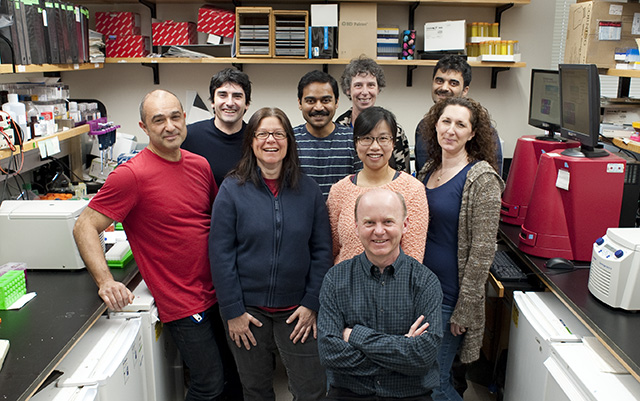
Eros Quarta initiated and led the study. He has since returned to the University of Florence and completed his Ph.D.
A team of scientists in NCI at Frederick’s Center for Cancer Research Mouse Cancer Genetics Program and their collaborators at the University of Florence have identified a link between the presence of a growth factor receptor and cognitive impairments in patients with amyotrophic lateral sclerosis (ALS, also known as Lou Gehrig’s disease).
ALS is mainly known as an incurable disease caused by severe degeneration of the spinal cord, leading to extreme paralysis and, for most patients, death within three to five years. However, one-third of ALS patients also suffer from decreased cognitive ability, lack of coordination and navigation, and behavioral impairment that collectively lead to dementia. In essence, they lose their mental faculties even as they become physically trapped by their paralysis.
The research team has shed new light on why these impairments occur. According to their study, published in Molecular and Cellular Neuroscience, a form of the growth factor receptor tropomyosin receptor kinase B (TrkB) called “T1” may be significantly responsible. (Growth factor receptors are protein molecules that help to initiate the process by which cells grow and divide.)
TrkB.T1 naturally exists on several types of neurons—clusters of cells that transmit electrical signals—in the central nervous system. In patients with ALS, however, it may function improperly. By deleting the gene that codes for TrkB.T1 in mice with early stage ALS, the team was able to demonstrate that TrkB.T1’s presence is correlated with a loss of function in a group of neurons that control cognitive ability. ALS mice without TrkB.T1 exhibited levels of functioning neurons very similar to those of healthy mice.
Deleting the gene in ALS mice also improved electrical signals in the hippocampus—the part of the brain related to memory and navigation. As a result, the brain function of ALS mice without TrkB.T1 resembled that of mice that never had the disease.
More studies are needed, but if they prove successful, they could identify TrkB.T1 as a new target for therapies aiming to treat ALS.
“We would like to define the molecular mechanism leading to the rescue,” said senior investigator Lino Tessarollo, Ph.D., director of the Mouse Cancer Genetics Program and head of the program’s Neural Development Section. “We are still interested in pursuing this research.”
Even so, the researchers caution that additional study, if it leads to drug development, could take years.
Work on their study began in 2012 after Eros Quarta, a Ph.D. student at the University of Florence, joined Tessarollo’s lab to expand upon earlier research. Quarta’s previous work showed that ALS mice possessed a reduced number of neurons that was associated with cognitive impairments resembling those in humans, and he wanted to know the mechanism responsible for it.
Around the same time, a staff scientist in Tessarollo’s lab, Sudhirkumar Yanpallewar, M.D., published a study demonstrating that deletion of the gene coding for TrkB.T1 saved the neurons responsible for motor function in ALS mice and slowed the onset of paralysis. Because TrkB.T1 was also known to exist on neurons associated with cognitive function, Quarta approached Yanpallewar with a proposal for the current study, and the duo worked together to investigate. From there, they called upon colleagues for help, including Gianluca Fulgenzi, Ph.D., an electrophysiologist and staff scientist in Tessarollo’s lab, who investigated the electrical signals in the hippocampi of the mice.
“This was a project initiated by a student and gradually developed by bringing in different expertise from the laboratory,” Tessarollo said.
Tessarollo’s lab, in turn, offered a unique place to conduct the research. He and his colleagues mainly study the role of Trk genes in the healthy brain and other organs, not ALS.
“The genes we study, when mutated, can cause cancer, so we want to understand what their normal function is, in order to see if their inactivation during cancer treatment can lead to side effects,” Tessarollo said.
However, that work inspired them to study other diseases like ALS. Their expertise in Trk genes proved to be one of the driving forces in Quarta’s partnership with Yanpallewar. Combined with the group’s additional expertise in developing and using mouse models of various diseases, it made the lab perfectly suited for the study.


